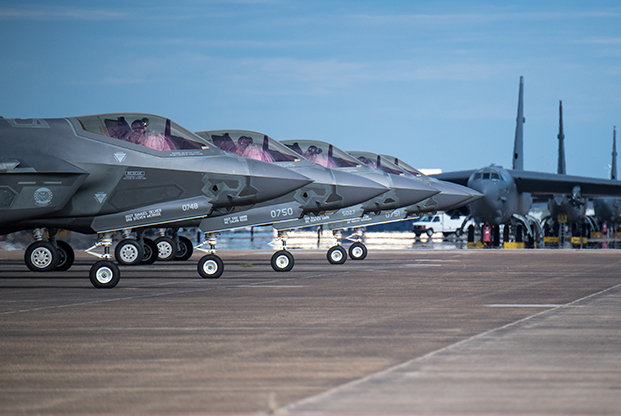
F-35s from Eglin AFB, Fla., prepare for takeoff at Barksdale AFB, La., Oct. 12, 2018. Air Force photo by A1C Lillian Miller.?
F-35s that evacuated from Eglin AFB, Fla., during Hurricane Michael in October were subject to the grounding and fuel line inspection at their temporary base in Louisiana, forcing maintainers to work quickly and find new ways to accomplish the inspection.
The Defense Department on Oct. 11 grounded all F-35s to inspect fuel tubes following the Sept. 28 crash of a USMC F-35B in South Carolina. These inspections included F-35As from Eglin’s 33rd Fighter Wing that were evacuated to Barksdale AFB, La., on Oct. 9 in advance of the storm.
The work required maintainers to remove the F-35 engine—a 36-hour process per jet. Engine trailers and tools also needed to be transported to Barksdale, and parts within a specific batch number had to be replaced, according to a Jan. 3 release from the 33rd Fighter Wing.
“It was particularly worrisome for us because we had jets off station without access to all of our tools and personnel,” 1st Lt. Patrick Michael, 58th Aircraft Maintenance Unit assistant officer in charge, said in the release. “We didn’t have the guidance for changing out the part yet. The preliminary guidance said we would need to remove the engine to access and remove the line.”
After the storm had passed, maintainers working with the jets at Barksdale determined that eight jets needed to have the part replaced. The rest of the aircraft returned to Eglin while maintainers and contractors at the Florida base tried to find a way to do it differently.
Crew chiefs at Eglin discovered they could access the problem area through a hole that could just fit their hand, instead of removing the entire engine. The discovery shaved at least 12 hours off the projected time to fix each jet and limited the impact to F-35 training. Eglin initially expected a two-month delay for graduations, but the accelerated process let the training program return to a full schedule within two weeks and nine F-35 pilots were able to graduate on time, Lt. Col. David Cochran, the 58th Fighter Squadron director of operations, said in the release.
The grounding impacted all global operators of the F-35, including USMC aircraft deployed to the Middle East. Pratt & Whitney said it was “rapidly procuring” more parts during the grounding to minimize the repair timeline. The Air Force would not specifically say how many aircraft were impacted, but that a “majority” of the aircraft returned to flight shortly after the grounding was announced.